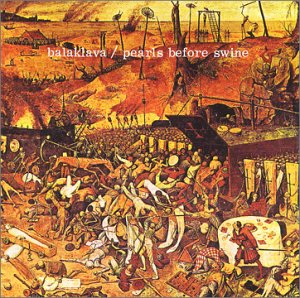- Balaklava (album)
Infobox Album
Name = Balaklava
Type =Album
Artist = Pearls Before Swine

Background = lightsteelblue
Released = 1968
Recorded =
Genre =Psych folk ,folk rock
Length = 29:49
Label =ESP-Disk ESSP 1075
Producer = [http://www.answers.com/topic/richard-alderson?cat=entertainment Richard L. Alderson]
Reviews = *Allmusic Rating|4.5|5 [http://www.allmusic.com/cg/amg.dll?p=amg&sql=10:rfu36j7h71e0 link]
Last album = "One Nation Underground"
(1967)
This album = "Balaklava"
(1968)
Next album = "These Things Too "
(1969)Balaklava was the second album recorded and released by psychedelic folk group Pearls Before Swine, in 1968.
For the album, original group members
Tom Rapp , Wayne Harley and Lane Lederer were joined by Jim Bohannon, who replaced Roger Crissinger. Like the group’s previous LP onESP-Disk , "One Nation Underground", it was recorded at Impact Sound in New York City. Recordings probably took place in early 1968 – although some CD reissues state that it was recorded in 1965, this appears to be an error. Lederer left the group during, or shortly after, the recordings, and the basic group was augmented by studio musicians.Rapp has stated [ [http://www.dirtylinen.com/feature/50rapp.html Tom Rapp ] ] that he wanted to produce a themed anti-war album, and chose the
Charge of the Light Brigade atBalaklava in 1854 as an example of the futility of war. The album was dedicated to Private Edward Slovik, the only US soldier executed for desertion in the Second World War. The front cover, a detail of "The Triumph of Death " byPieter Brueghel the Elder , showed a grotesque allegorical depiction of the horrors of war, while the back cover showed a photograph of a young girl at an anti-war protest. The cover also included the quote "”Only the dead have seen the end of war”" byGeorge Santayana , together with surreal and horrific drawings byJean Cocteau . Incidentally, the cover contributed to the mystique surrounding the group - there were few if any photographs of its members published, and Pearls Before Swine did not perform in concert before 1971.The album itself starts with a recording of “Trumpeter Landfrey” (his name was in fact Martin Lanfried) [ [http://library.wellcome.ac.uk/doc_WTX023017.html Florence Nightingale remastered ] ] [ [http://www.archive.org/details/EDIS-SWDPC-01-04 Internet Archive: Details: Trumpeter Landfrey's Charge of the Light Brigade ] ] , one of the original buglers from the 1854 battle. Together with the recording of
Florence Nightingale later on the album, this was taken from an archive 1890 cylinder recording, which had been reissued on 78rpm records in the 1930s.The recording segues into "Translucent Carriages", one of Rapp’s most lasting songs (which he performed, for instance, at the Terrastock 6 Festival in 2006). Simply performed with acoustic guitar, it is rendered otherworldly by breathing noises and whispered lines of commentary, including the quote from the ancient Greek historian
Herodotus - "In peace, sons bury their fathers / in war, fathers bury their sons.""Images of April", in contrast, is an evocation of nature, featuring dubbed bird song. After "There Was A Man", a simpler story-based folk song, another highlight is "I Saw The World". Its innocent but heartfelt lyric (Rapp was just 21 at the time) - "I saw the world spinning like a toy / Hate seems so small compared to it all, so why don’t you do joy ?" - is supplemented by overdubs of natural sounds including waves, as well as wind chimes and a lush string arrangement. "Guardian Angels" is a ballad recorded deliberately to sound as it if it were on a scratchy 1920s 78rpm record, and was presented as such ("recorded in Guadelope, Mexico, in 1929…" ) on the sleeve.
The generally less artistically successful second side of the original LP starts with a version of
Leonard Cohen 's "Suzanne" , followed by Rapp’s original "Lepers and Roses", a complex ballad full of allegorical classical references. After the archive recording of Florence Nightingale, the final track, "Ring Thing", is a dramatic evocation ofTolkien 's 'Lord of the Rings ' with crashing gongs and bagpipe drones. At the end, the sound of a tape spooling backwards through the album takes the listener back to "Trumpeter Landfrey" – the message seeming to be that the cycle of war and confusion is destined to continue.The album repeated its predecessor’s critical success on the underground college scene of the late 1960s, and has subsequently been regularly rated most highly of all Rapp’s albums. Following the album's release, Rapp extricated himself from his ESP contract and signed with
Reprise Records . After seven further albums he retired from music in the mid-1970s to qualify and work as a lawyer, returning to perform and record occasionally after the mid-1990s. "Balaklava" has been reissued several times on CD since the 1980s.Track listing
# "Trumpeter Landfrey" – 0:35
# "Translucent Carriages" – 4:00 (Herodotus/Harley/Rapp)
# "Images of April" – 2:44 (Rapp)
# "There Was a Man" – 2:59 (Rapp)
# "I Saw the World" – 3:28 (Rapp)
# "Guardian Angels" – 3:02 (Rapp)
# "Suzanne" – 5:01 (Cohen)
# "Lepers And Roses" – 5:23 (Rapp)
# "Florence Nightingale" – 0:17
# "Ring Thing" – 2:20 (Tolkien/Rapp)Credits
*
Tom Rapp – guitar, vocals, breathing
*Jim Bohannon – organ, piano, clavinette, marimba
*Wayne Harley – banjo, harmony
*Lane Lederer – bass, guitar, swinehorn*Guest artists :-
**Joe Farrell – flute, English horn (tracks 3, 7)
**Lee Crabtree – piano, organ, flute (tracks 5, 8)
**Bill Salter – bass (tracks 5, 7, 8, 10)
**Al Shackman – guitar (track 8)
**Warren Smith – string arrangements (track 5)
**Selwart Clarke – string arrangements (track 6)*"Arielvaced out of Onlyville by Richard L. Alderson, Impact Sound, N.Y.C."
*"We wish to dedicate this album to Pvt. Edward D. Slovik, U.S. Army, deceased"
References
External links
* [http://members.chello.nl/cvanderlely/pearls/disco/lyrics.html#balak Lyrics to Balaklava]
* [http://www.allmusic.com/cg/amg.dll?p=amg&sql=10:rfu36j7h71e0 AMG review]
* [http://www.emusic.com/album/10668/10668325.html EMusic review]
* [http://www.pbswine.com/ Official site for Tom Rapp and Pearls Before Swine]
* [http://profile.myspace.com/index.cfm?fuseaction=user.viewprofile&friendid=57218849 Fan site on MySpace]
Wikimedia Foundation. 2010.
